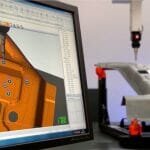~ Could maintenance engineers work from home? ~
The year 2020 has been named the ‘year of remote work’, due to the changing work conditions caused by the COVID-19 pandemic. For many occupations, a suitable work environment requires no more than a desk, a PC and an Internet connection. However, maintenance engineers require innovative technology and expert software. In this article, Neil Ballinger, head of EMEA at industrial parts supplier EU Automation, discusses the requirements of remote working maintenance engineers.
Challenging working conditions require innovative and effective solutions, one being remote condition monitoring (RCM) for industrial equipment. Remote condition monitoring is the ability to view the performance, status and behaviour of a machine from a distance in real time. This is achieved with a combination of Internet of Things (IoT) technology and cloud computing that allows an on-site machine to be tracked by maintenance engineers wherever they are.
How does RCM work?
To be effective, RCM uses three key components — stable connectivity to collect data, a platform to process and store them, and tools to present them to engineers.
Firstly, sensors are being attached to the plant equipment to continuously relay vast amounts of data. The latest machinery comes equipped with such sensors, but for older assets, these sensors can be added into the existing structures. Collecting data requires a standardised industrial connectivity that can support an Industrial IoT platform. The platform establishes a secure connection between the machines and the sensors and provides real-time notifications alerts and cloud storing services.
After data is collected, it needs to be stored and processed accordingly. The metrics are sent to the cloud and stored on the IoT platform to be transformed into actionable information.
Finally, this information is delivered through dashboard applications or mobile notifications to a maintenance engineer. Remote monitoring solutions using the latest applications will also leverage additional features, such as intelligent queuing or routing of notifications, geospatial directions of the asset or even service instructions. From here onwards, if engineers detect a problem in one of the machines, they can perform root cause analysis, order replacement parts, and direct the maintenance team, all from the comfort of their own houses.
Added benefits of augmented reality
In recent months, large corporations have trialled virtual reality headsets for meetings to give people the impression they sat next to each other. The challenge for maintenance engineers is not only to find a suitable remote working environment, but also to train future engineers for the growing demand in the field. Augmented reality (AR) could replace face to face training and deliver innovative experiences for workers to develop their skills.
Regardless of their location, workers can come together in a virtual setting and share information, while also tracking their work progress in real time. Not only could workers step into a virtual training session, but their work on analysing large amounts of data can be simplified by presenting the data in a visual form, regardless of where they are and what they are doing. For example, as the workplan appears before their eyes, it can be analysed while walking the dog or enjoying a sunny day in the garden.
Thanks to RCM and augmented reality, potential problems can be spotted early on and replacement parts can be ordered before failures can cause downtime and generate financial loss. EU Automation supplies new, reconditioned and obsolete automation and control parts quickly anywhere in the world. This way a maintenance engineer in the United Kingdom could, for example, assist a machine in a plant in Australia in the quickest time. Not only would this reduce downtime, it would also mean experts all over the world could help each other and share knowledge.
While solutions like remote condition monitoring and augmented reality may seem farfetched, the changing conditions of remote working could make them a reality in the near future. For maintenance engineers, such solutions could ensure they are able to do their job from the comfort and safety of their own houses.
To find out more about automation and control parts and how these can be delivered anywhere in the world, visit www.euautomation.com.





